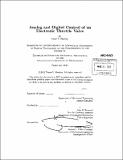| dc.contributor.advisor | John B. Heywood. | en_US |
| dc.contributor.author | Martins, Tomás V | en_US |
| dc.contributor.other | Massachusetts Institute of Technology. Dept. of Mechanical Engineering. | en_US |
| dc.date.accessioned | 2012-07-02T15:48:50Z | |
| dc.date.available | 2012-07-02T15:48:50Z | |
| dc.date.copyright | 2012 | en_US |
| dc.date.issued | 2012 | en_US |
| dc.identifier.uri | http://hdl.handle.net/1721.1/71507 | |
| dc.description | Thesis (S.B.)--Massachusetts Institute of Technology, Dept. of Mechanical Engineering, 2012. | en_US |
| dc.description | Cataloged from PDF version of thesis. | en_US |
| dc.description | Includes bibliographical references (p. 32). | en_US |
| dc.description.abstract | Two electronic throttler controllers were designed and implemented for an automotive throttle valve on a four-cylinder, spark-ignition gasoline engine. The first controller was designed using operational amplifiers and other analog componentry to realize a proportional-integral controller and feedback loop. The second controller utilized a programmable digital microcontroller to replace the analog componentry for signal processing. The use of analog to digital signal conversion by the microcontroller allows for the simple implementation of control logic and feedback loops through programming. Additionally, control architecture and characteristic gains implemented in the controller's code can be quickly changed and uploaded during testing. The digital controller was tested on the engine's throttle valve during motoring to demonstrate its actuation capabilities and response times. The digital controller was programmed to quickly switch between different feedback signals like throttle angle, manifold pressure, and indicated mean effective pressure for control. The controller was designed for use in experimental testing of an experimental 2.0 liter, GM EcoTec engine in the Sloan Automotive Laboratory at MIT. This study shows that rapid controller prototyping can be accomplished by using an inexpensive microcontroller for signal processing. This design concept greatly decreases implementation time and performance optimization time, increases controller flexibility and capabilities, and maintains favorable response characteristics. | en_US |
| dc.description.statementofresponsibility | by Tomás V. Martins. | en_US |
| dc.format.extent | 36 p. | en_US |
| dc.language.iso | eng | en_US |
| dc.publisher | Massachusetts Institute of Technology | en_US |
| dc.rights | M.I.T. theses are protected by
copyright. They may be viewed from this source for any purpose, but
reproduction or distribution in any format is prohibited without written
permission. See provided URL for inquiries about permission. | en_US |
| dc.rights.uri | http://dspace.mit.edu/handle/1721.1/7582 | en_US |
| dc.subject | Mechanical Engineering. | en_US |
| dc.title | Analog and digital control of an electronic throttle valve | en_US |
| dc.type | Thesis | en_US |
| dc.description.degree | S.B. | en_US |
| dc.contributor.department | Massachusetts Institute of Technology. Department of Mechanical Engineering | |
| dc.identifier.oclc | 796501020 | en_US |
